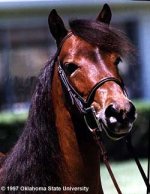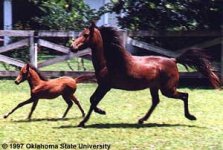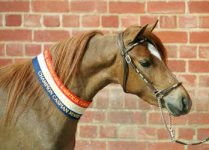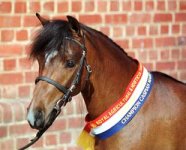♘امیرحسین♞
♘ مدیریت انجمن اسب ایران ♞
The Caspian is an ancient breed previously believed to have been extinct for over one thousand years. This breed is probably the most direct ancestor of the Oriental breeds and subsequently of all light horse breeds.
The Caspian is extremely rare and barely pulled back from the edge of extinction in 1965. It is now being studied by leading archaeozoologists to prove the link between the modern Caspian and the tiny prehistoric horse of Persia.
Louise Firouz, an American living in Iran, is credited with recognition of this ancient breed.
The Caspian head is short and fine with large eyes, a small muzzle, and large nostrils placed low. There is a pronounced development of the forehead, the ears are very short; the neck is slim and graceful, well attached to sloping shoulders; withers are pronounced; the back straight; and the tail set high on a rather level croup. The legs are slim with dense, strong bone and no feathering at the fetlock. The hooves are extremely strong and oval-shaped, more like those of the ass than the horse. The overall impression of the Caspian is that of a vary small, well-proportioned horse. Subsequent studies confirmed the visual picture osteologically; the Caspian is a miniature horse, not a pony. The color ranges from bay, gray, or chestnut and occasionally black.
A survey conducted from July of 1965 through August 1968 to determine the range and approximate number of remaining Caspians. The survey indicated that there were approximately fifty small horses with definite Caspian characteristics along the entire littoral of the Caspian Sea. Due to the fact that the individuals were widely scattered, it was virtually impossible for any of them to be considered completely pure.
During the period from 1965 to 1970 seven mares and six stallions were used for breeding at Norouzabad Stud. During that time it was observed that the growth of the Caspian is distinctive in that most of the height is attained within the first six months of life and subsequent growth is minimal, mostly being in width and secondary sexual characteristics. Sexual maturity is reached in both colts and fillies at about eighteen months.
The mares have a strong tendency not to ovulate until about a year after foaling, making a continuous breeding program difficult. Due to the improved conditions and feed, the mature height of offspring born at Norouzabad is smaller than the average height of sire and dam, possibly indicating that the original size of the Caspian is closer to 9 hands. This also indicates that the present stock is not completely pure and that breeding to type will further emphasize the true conformation of the Caspian and lead to a return of the natural size.
The Caspian is no longer in danger of extinction, although the breed is still extremely rare. Several studs now exist in Britain and a few individuals have been exported to Australia, New Zealand and the United States.
The Caspian is very versatile and is becoming known in the show ring with its exceptional jumping ability. The driving poweress that endeared it to Darius the Great still makes this horse a favorite in harness.
The Caspian is extremely rare and barely pulled back from the edge of extinction in 1965. It is now being studied by leading archaeozoologists to prove the link between the modern Caspian and the tiny prehistoric horse of Persia.
Louise Firouz, an American living in Iran, is credited with recognition of this ancient breed.
The Caspian head is short and fine with large eyes, a small muzzle, and large nostrils placed low. There is a pronounced development of the forehead, the ears are very short; the neck is slim and graceful, well attached to sloping shoulders; withers are pronounced; the back straight; and the tail set high on a rather level croup. The legs are slim with dense, strong bone and no feathering at the fetlock. The hooves are extremely strong and oval-shaped, more like those of the ass than the horse. The overall impression of the Caspian is that of a vary small, well-proportioned horse. Subsequent studies confirmed the visual picture osteologically; the Caspian is a miniature horse, not a pony. The color ranges from bay, gray, or chestnut and occasionally black.
A survey conducted from July of 1965 through August 1968 to determine the range and approximate number of remaining Caspians. The survey indicated that there were approximately fifty small horses with definite Caspian characteristics along the entire littoral of the Caspian Sea. Due to the fact that the individuals were widely scattered, it was virtually impossible for any of them to be considered completely pure.
During the period from 1965 to 1970 seven mares and six stallions were used for breeding at Norouzabad Stud. During that time it was observed that the growth of the Caspian is distinctive in that most of the height is attained within the first six months of life and subsequent growth is minimal, mostly being in width and secondary sexual characteristics. Sexual maturity is reached in both colts and fillies at about eighteen months.
The mares have a strong tendency not to ovulate until about a year after foaling, making a continuous breeding program difficult. Due to the improved conditions and feed, the mature height of offspring born at Norouzabad is smaller than the average height of sire and dam, possibly indicating that the original size of the Caspian is closer to 9 hands. This also indicates that the present stock is not completely pure and that breeding to type will further emphasize the true conformation of the Caspian and lead to a return of the natural size.
The Caspian is no longer in danger of extinction, although the breed is still extremely rare. Several studs now exist in Britain and a few individuals have been exported to Australia, New Zealand and the United States.
The Caspian is very versatile and is becoming known in the show ring with its exceptional jumping ability. The driving poweress that endeared it to Darius the Great still makes this horse a favorite in harness.




